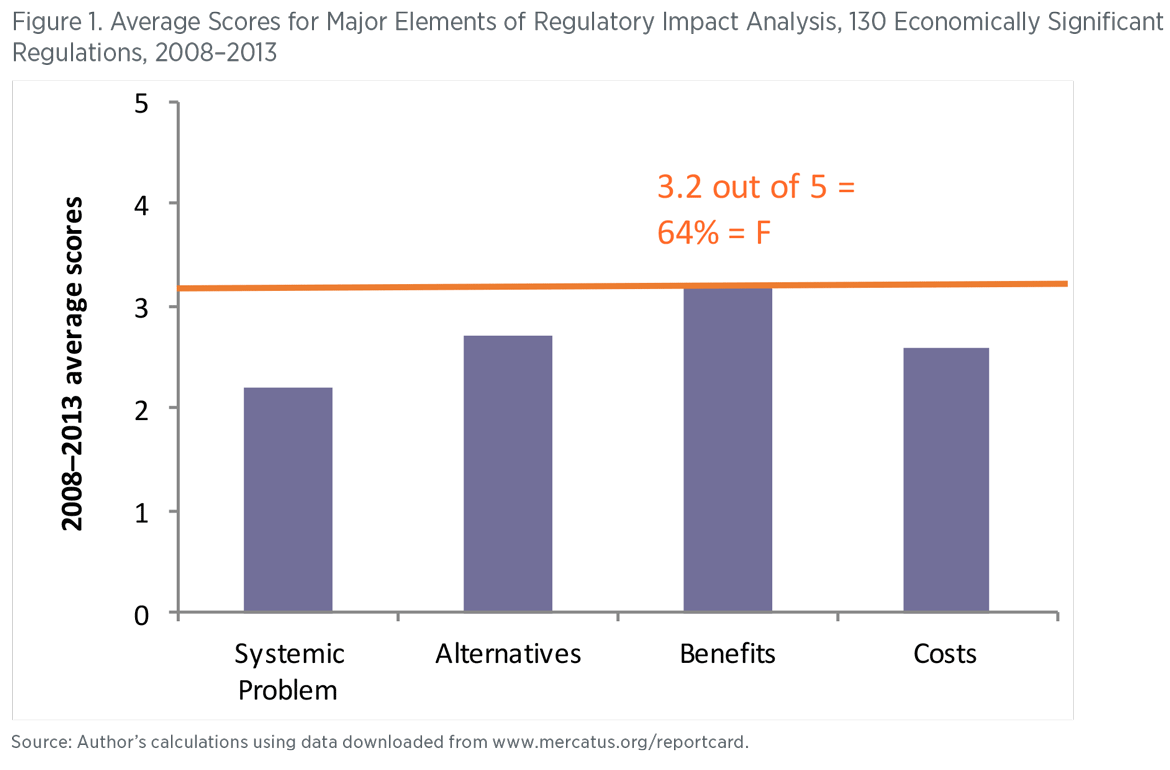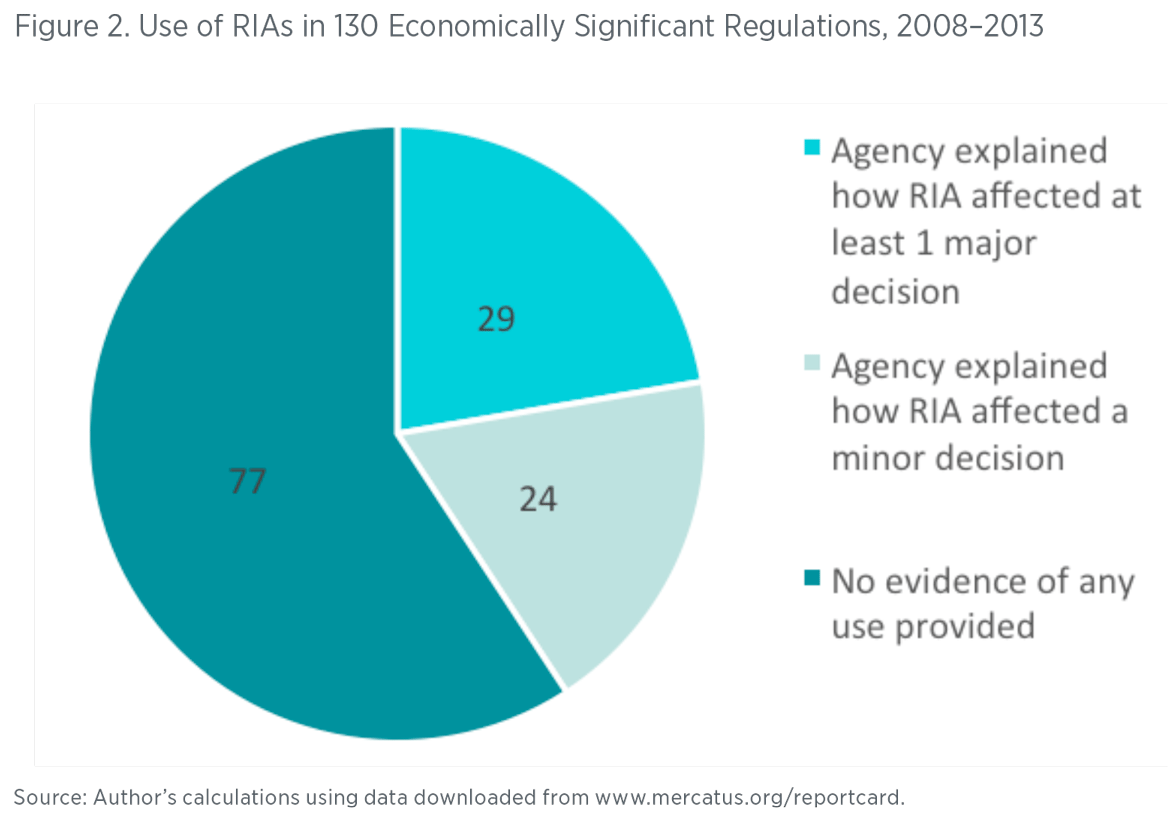- | Academic & Student Programs Academic & Student Programs
- | Regulation Regulation
- | Federal Testimonies Federal Testimonies
- |
Outcome-Based Regulatory Decisions Require Congressional Commitment
Testimony before the Senate Committee on the Budget
Citizens expect federal regulation to accomplish a lot of important things, such as protecting us from financial fraudsters, preventing workplace injuries, preserving clean air, and deterring terrorist attacks. Regulation also requires sacrifices; there is no free lunch. Depending on the regulation, consumers may pay more, workers may receive less, our retirement savings may grow more slowly due to reduced corporate profits, and we may have less privacy or less personal freedom. Given the important values at stake, Congress and regulatory agencies should craft regulations with full knowledge of their results. Decision-making in the dark should not be an option.
Good morning Chairman Enzi, Ranking Member Sanders, and members of the committee. Thank you for inviting me to testify today.
I am an economist and research fellow at the Mercatus Center, a 501(c)(3) research, educational, and outreach center affiliated with George Mason University in Arlington, Virginia. I’ve previously served as a senior economist at the Joint Economic Committee and as deputy director of the Office of Policy Planning at the Federal Trade Commission.
Decision makers—legislators as well as regulators—have a moral responsibility to make decisions about regulations based on actual knowledge of a regulation’s likely outcomes—not just hopes, intentions, or wishful thinking. A decision maker’s failure or refusal to acquire this knowledge before making a decision is a willful choice to act based on ignorance. For effective decision-making, Congress and regulators both need access to the best possible assessment of the likely results of prospective regulations and the actual results of regulations that are already in force.
The Mercatus Center at George Mason University has undertaken two long-term research projects that directly assess the quality of federal agencies’ information about the prospective and actual results of government programs and regulations. One is the Performance Report Scorecard, which evaluated the quality of federal agencies’ annual performance reports required under the Government Performance and Results Act (GPRA). The other is the Regulatory Report Card, which evaluated the quality of economic analysis produced by executive branch agencies for prescriptive, economically significant regulations proposed from 2008 through 2013.
From both of these projects, I have learned that telling agencies to conduct prospective analysis before they act (or retrospective analysis of the results of their actions) is no more than a useful first step. Regulations don’t enforce themselves, nor do analytical requirements. Stronger incentives are necessary to: 1) focus regulatory agencies on results rather than outputs; 2) produce high-quality analysis that assesses results; and 3) explain how agencies used their analysis in decisions. To ensure that legislative and budget decisions focus on regulatory results, Congress also needs to commit itself to obtaining and using high-quality analysis when it authorizes regulation by statute and funds agencies to promulgate and enforce regulations.
Performance Report Scorecard
The Performance Report Scorecard was a 10-year research project that evaluated the quality of annual performance reports produced under GPRA by the 24 US federal agencies that account for more than 95 percent of all federal spending. A panel of experts with experience in government performance management evaluated agency reports based on 12 criteria found in GPRA. Principal findings from this project include:
- GPRA significantly improved the quality of performance information. On average, the quality of agency performance reports improved by about 75 percent between fiscal year 1999 and fiscal year 2008.
- However, even in 2008 there was still substantial variation in quality, with only a few reports each year employing best practices on each of the evaluation criteria.
- GPRA improved the availability and use of performance information in agencies, and results information affected some presidential budget proposals.
- However, there is little evidence that GPRA altered congressional budget decisions. Congress showed little interest in using results information to make budget decisions. On several occasions, appropriations committees instructed agencies not to include performance information in their budget submissions.
The improvement in agency performance reporting did not simply happen because GPRA required it. The improvement required a major internal push by the Office of Management and Budget (OMB) with the full backing of the president. Even then, the quality of many agency performance reports fell short of what one would expect given GPRA’s requirements and 10 years of intense effort. And the actual use of performance information in budgeting decisions was marginal at best.
Regulatory Report Card
Executive Order 12866 requires that before regulating, agencies must identify the problem they are trying to address and assess its significance, examine a wide range of alternatives to solve the problem, and assess the benefits and costs of the alternatives. The Regulatory Report Card is a qualitative evaluation of both the quality and use of regulatory analysis by executive branch agencies. The scoring criteria are based on requirements in Executive Order 12866 and OMB guidance to agencies. The scores do not assess whether the evaluators agree with the results of the analysis or believe the regulation is a good idea. For each criterion, trained evaluators assigned a score ranging from 0 (no useful content) to 5 (comprehensive analysis with potential best practices). The online Report Card database now includes evaluations of every economically significant prescriptive regulation proposed between 2008 and 2013—a total of 130 regulations.
Figure 1 shows average scores for the four major elements of Regulatory Impact Analysis. None of the average scores exceed 3.2 out of 5 possible points. If I were assigning letter grades, each of these would earn an “F.”
The broadest Report Card criterion measuring use of analysis asks whether the agency claimed or appeared to use any part of the analysis to guide any decisions. As figure 2 demonstrates, agencies often fail to provide any significant evidence that any part of the Regulatory Impact Analysis helped inform their decisions. Perhaps the analysis affects decisions more frequently than these statistics suggest, but agencies commonly fail to document this in the Notice of Proposed Rulemaking or the Regulatory Impact Analysis. If so, then at a minimum there is a significant transparency problem.


Studies find that regulatory review by the Office of Information and Regulatory Affairs is correlated with higher-quality analysis and better explanations of how agencies used the analysis in decisions. But as the Report Card and prior research on the quality of Regulatory Impact Analysis demonstrates, the quality and use of analysis falls far short of what one would expect after reading the principles and standards articulated in Executive Order 12866 and OMB guidance.
Conclusion
The results of these research projects lead me to two conclusions:
1. Regulatory analysis requirements, like regulations, do not enforce themselves. Putting analytical requirements in laws or executive orders does not by itself guarantee that agencies will conduct high-quality regulatory impact analysis, explain how they used the analysis in decisions, and produce desirable results for the public. When Congress delegates decision-making authority to regulatory agencies, strong incentives are needed to promote high-quality analysis, explain transparently how the analysis affected decisions, and encourage a focus on results.
Numerous regulatory reform proposals seek to change agency incentives to conduct and use high-quality analysis. From a budgetary perspective, some of the most relevant proposals include clear articulations of the outcomes Congress expects regulatory agencies to accomplish, budgetary consequences if agencies produce substandard analysis or fail to produce desirable results, and reform of Senior Executive Service bonuses so that they are based on regulatory results instead of regulatory output.
2. What’s sauce for the goose is sauce for the gander. Efforts under GPRA to improve the use of performance information foundered when it became clear that appropriations committees were not going to use performance information to make budgeting decisions. The same problem could easily occur with congressional decisions about regulations or regulatory programs. Congress often makes key regulatory decisions when it writes statutes that authorize or reauthorize regulations. The current system provides Congress with a flood of information but little structured means to produce high-quality analysis of the problems that regulatory legislation seeks to solve and the benefits and costs of alternative solutions. For this reason, Congress needs to develop a system for obtaining impartial legislative impact analysis when it authorizes new regulation or reauthorizes existing regulation.
Citizens expect federal regulation to accomplish a lot of important things, such as protecting us from financial fraudsters, preventing workplace injuries, preserving clean air, and deterring terrorist attacks. Regulation also requires sacrifices; there is no free lunch. Depending on the regulation, consumers may pay more, workers may receive less, our retirement savings may grow more slowly due to reduced corporate profits, and we may have less privacy or less personal freedom. Given the important values at stake, Congress and regulatory agencies should craft regulations with full knowledge of their results. Decision-making in the dark should not be an option.
Thank you for your time. I would be happy to answer any questions.
To speak with a scholar or learn more on this topic, visit our contact page.
